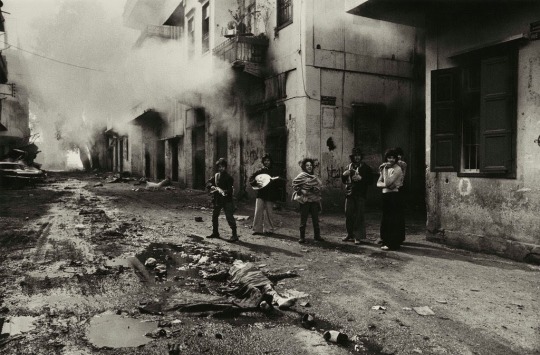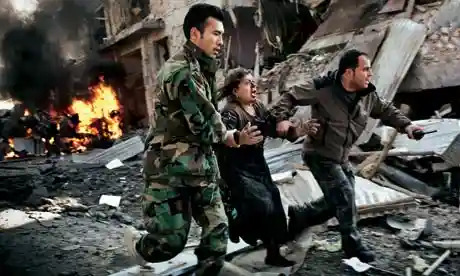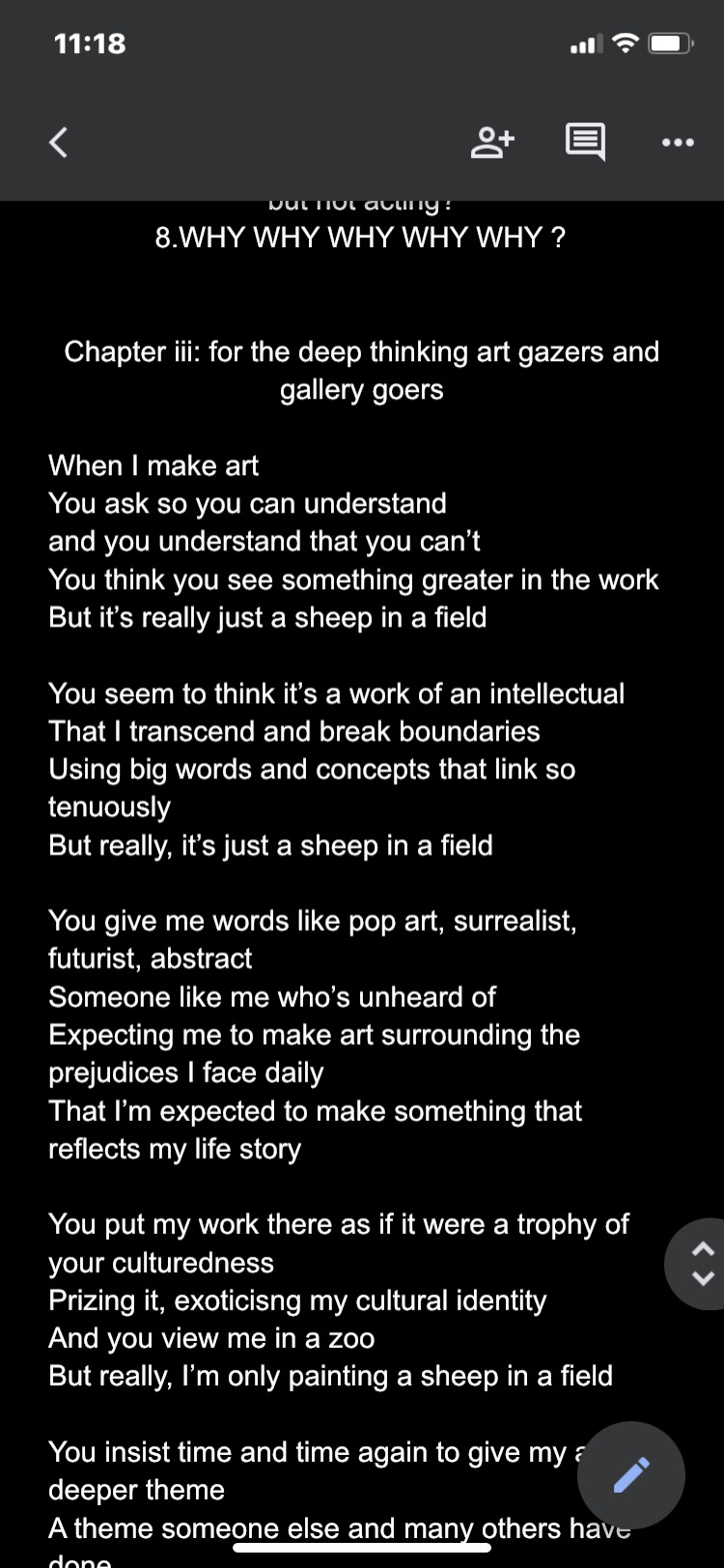Don't wanna be here? Send us removal request.
Text
The Importance of Photographing War and Suffering

Don Mcullin (Young chritsian Youth Celebrating Death of Palestinian Girl, Beirut, 1976)
Don Mcullin is a photojournalist who has been working for 50 years.
In this picture, children are seen standing near a corpse of a dead girl. A Palestinian girl. In a New york times article Don Mcculin states, “They said If you don't go we’re going to kill you” he also added, “ as I was going But as I was going i heard music and these boys were shouting mister mister take a picture and I thought christ i've got to go and I didnt even take an exposure reading”. By this quote Don Mcculins imagery captures that very moment with very little thought of the aesthetics and the perfection of the image. His work is very real and raw. At his Tate exhibition Don Mcullin says, “I’ve many times been right up to the precipice, not even a foot or an inch away. That’s the only place to be if you’re going to see and show what suffering really means…”

Phillip Jones Grifith American soldier offering water to a severely wounded Vietcong fighter 1968
In this image Americans are offering water to a Vietnamese fighter. This act shows how humanity can still be found in the most tragic of times. Phillip Jones Griffiths was another photo journalist who captured conflict. He is more widely known for his images from the Vietnam war He doesn't consider himself a traditional war photographer; he believes that ,“journalists should be by their very nature anarchists, people who point out things that are not generally approved of.” Phillip Jones Griffiths believes we have a lot of lessons to learn not just about war and killing people but how social systems are trying to take over the world. In his book Vietnam inc he accounts the war and exposes what went on and ultimately helped in ending the Vietnam war and changed the opinions of the public in American states. “Photographers are either mud people or sand people and I’m a mud person” Griffiths also stated, “I realized what we were being told couldn't possible be true and I decided I was going to be the one to know what was really going on”

Adam Ferguson Afghanistan, 2009 “As a photographer, you feel helpless. Around you are medics, security personnel, people doing good work. It can be agonizingly painful to think that all you're doing is taking pictures.”
In the above image, shown is a suicide bombing and the woman is being escorted. In Adam Ferguson witnessed flames, bodies and explosions “it was still very fresh and there was a risk of another bomb” he also states “ it was one of those situations where you have to put your fear aside and focus at the job at hand to watch the situation and document it” Adam Fergusus did not want to make the soldiers look like heroes and make the fight in Afghanistan look like a noble fight.
What all the above photographers have in common is the fact that they want the viewer to feel something when they look at the images.

George Strock Three dead Americans, killed during the fight to take Buna Beach from the occupying Japanese forces, Papua New Guinea, 1943.
Other photographers refused to stay and photograph the Battle of Buna but George strock stayed. In the Island George Stock had to live amongst the soldiers; they didn't have time to bury the dead either because they were fighting. At the time the Image was to be Censored because the showing of dead Americans was socially unacceptable but LIFE (the Picture collection company) raised the issue to the government and President Franklin Rosevelt himself thought the public needed to see the harsh realities of war. George Strock Nearly died twice during his mission in New guinea “when I took pictures I wanted to bring the viewer into the scene” George Stock is one of the few photographers that risked their lives by taking pictures “two photographers left after taking their first taste of fire” The Battle of Bunna is described as being as bloody as World war Two conflicts unfortunately no names of the lives losts are within public knowledge. Q

Alexander Gardner Home of a Rebel Sharpshooter 1865 “What visions, of loved ones far away, may have hovered above his stony pillow! What familiar voices may he not have heard, like whispers beneath the roar of battle, as his eyes grew heavy in their long, last sleep!”
In some bizarre cases, war photography can be staged. This was practiced during the civil war as the growing popularity of war photography increased, photographers aimed to capture the most emotive picture as they could. They would add props or even move bodies to achieve these. Photo manipulation is something practiced to this day but not as chilling as what Alexander Gardner has been claimed to have practiced. In 1895 an assistant to the gardener had heard how the photographer works. Because travel wasn't like today in the Civil War, photographers would have arrived at Battles once it was all over. Only Carcesus would have been left behind as a result, they would move the bodies and pose them in ways to look believable and add props.
4 notes
·
View notes
Text
“Photographers are always imposing standards on their subjects”

Don Mcculin
The image I’m reflecting on is a photograph taken by Don McCulin. It shows a mother with her child being fed at her breast in Biafra in the year 1968 when Biafra was at war with Nigeria and there was a mass amount of starving people . Don McCulin is a photographer that has been going to countries that are in the mist of war since the 1960s and takes pictures of the aftermath and effects it has on the people. As stated in this blog entries title, this line from the book stuck out to me as the writer Susan Sontag of the book ‘On Photography’ claims that standards are set when photographers capture images I disagree as I believed it is very dependant on what type of photography you do. Looking at Don McCulin work and knowing that he immersed himself into the terrifying war stricken countries and taking pictures of real people Is fascinating to me because he wants us to see the peoples realities and make us feel what the subject is feeling. war photographs capture the still life’s of peoples suffering and the severity of what they go through.
References:
Sontag, S., 2001. On photography. Macmillan.
1 note
·
View note
Text





Group manifesto
P.E.B.B.O was born out of a task of creating group manifestos. It consisted of myself, Edward and Paris. Working as a trio was really successful for us as all of our ideas fell together almost harmoniously it was really easy to discuss ideas and topics that we were all collectively felt passionate about.
Chapter ii written by me
0 notes
Text
100 Artsist’s manifestos
Takashi Murakami
I decided to look at Takashi Murakamis work because I recognised and I enjoy his art. Takashi Murakami’s work is in the super flat art style which is an art movement Takashi Murakami started himself which involves imagery with bold outlines filled in with block colour and lacks three dimensionality. His work seems to be heavily influenced by anime and manga styles . in the manifestos the word also used to describe his work is poku which is a fusion of otaku and pop art. Murakami in his manifesto was hopeful that otakus (fans of the anime and manga media) will cause a culture revival which I have observed may be happening now. I. My eyes I’m seeing more people are more comfortable with sharing and expressing that they enjoy anime and manga especially online and started to appreciate the Japanese culture as a whole compared to years ago when you would be considered ‘weird’ or ‘strange’ for enjoying it. You could also say it’s making its way to the mainstream and is growing in popularity.

Reference: Danchev, A. (2011) 100 artist manifestos. London: Penguin
1 note
·
View note
Text

My final piece
I photoshopped and overlapped imagery I captured on my walks with continuous lines that showed the turns I made on walks through my area to demonstrate the repetition of my daily routine.
0 notes
Text
A tiktok I made of my walk playing around with exposure and editing on my phone
0 notes
Text






Here I was starting to experiment with photography and photoshop layering work I done so far.
0 notes
Text







I decided to go on walks and draw lines of turns and directions I took down roads in different coloured felt tip pens.
0 notes
Text




My 10 minute derive to Bellingham green. Not a lot intrigued me about the place so I wasn’t as enthusiastic probably due to the fact that it’s so familiar To me. I drew lines that followed Turns I made on Pavements, drew a few cars, a house that I saw on my way and when I got to the Bellingham green park I drew people playing basketball
0 notes
Text
My thoughts on Theory of the Dérive by Guy Debord
Theory of the Dérive according to my understanding is an explanation of what a derive is by Guy Debord. what I found was that the text was very contradictory. Guy Debord explains how you shouldn’t allow outside influences to affect your Dérive but then talks about logical ways to go about the derive which in my opinion is not very freeing as an artistic practice. a part of the text that stuck out to me was when Debord speaks on Pirerre Vendryes who talks about the distribution of tadpoles and compares that to three surrealists that went on a mindless walk. Vendryes further speaks on how the tadpoles are more liberated than the surrealists even though they claim the walk is ‘mindless’. “as stripped as possible of intelligence, sociability and sexuality” was a quote that particularly stuck out to me. it’s interesting because it is true as humans we take in so much information since the day we a born so in turn it is close to impossible to have a pure mind that’s stripped of everything.
1 note
·
View note